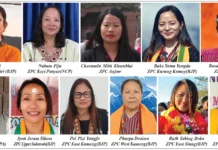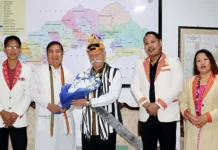[ Manoranjan Pegu ]
The killing of two Mising youths in Arunachal within a month has put the spotlight on the migrant worker situation in Arunachal. In the first instance, Probash Doley, a 22 year old, who did odd jobs on the side to support his preparation for police recruitment examinations, was killed with a machete by Tai John over a noise complaint argument. Doley had just come for a day to do some roofing work. Not even a month had passed, and Shankar Pegu was shot at by Tadar Bhai over a ‘workplace argument’. Pegu was declared dead at the hospital.
The Takam Mising Porin Kebang (All Mising Students Union) in the first instance was pretty restrained and issued a statement calling for speedy justice. A delegation also met with the SP of the district and submitted their demand. However, by the second incident, the Mising organizations called for large-scale blockades of the border roads. Demonstrations were organized in Banderdewa, Gohpur-Hollongi-Itanagar road, Likabali-Silapathar road, Tezpur-Balipara-Balukpung road, Sadiya-Roing-Anini road and Ruksin gate. effectively closing all roads connecting the states of Assam and Arunachal. By noon, the blockades were lifted as the respective state governments of Assam and Arunachal had discussed with each other and a promise of speedy justice was made.
The instances generated large-scale identitarian responses, but should also be understood in the larger context of capitalist transformation of Arunachal and the migrant labour regime in the state and the Northeast in general. This also calls for a larger understanding of the evolution of tribal population into a pool of wage labour.
DK Mishra (2023), in his piece, ‘Agrarian Relations and institutional diversity in Arunachal Pradesh’, highlights that “Capital did not enter Arunachal Pradesh in search of raw materials, labour or markets. It entered this border state to strengthen state power. This is true for the majority of the states in the Northeast. As these states shared international boundaries, a large-scale security apparatus was being developed in these regions. Thus, infrastructure and large-scale projects began to emerge, effectively leading to a development of market capitalism.”
Mishra further highlights that the community elite allied with the government and outside capitalist class to get large-scale contracts or lease out their land and infrastructure, leading to a development of the rentier class. Thus, to him, the “interests of capital, for a considerable period at least, remained subservient to the interests of the state. The resulting capitalist trajectory has many distinct features…including commercialisation without de-peasantisation; the emergence of a rentier class within and outside agriculture; and elements of neo-bondage in landlord-migrant tenant contracts.”
It is this rentier class which becomes the agency of mobilising and controlling local and migrant labour in the larger interests of capital pursued in the name of regional development and growth.
Migration of Misings to Arunachal
For a layman, it is important to reiterate that the Misings were originally a hill tribe and moved to the plains of Assam from Arunachal (earlier called NEFA). Along with other communities, such as Adi, Apatani, Galo, Nyishi and Tagin, Misings trace a common ancestry and have shared belief systems, rituals and culture. These five communities are collectively termed as Tani people and have a combined population of approximately 2.17 million people.
Of the five tribes, the Misings moved to Assam. In 1951, soon after the formation of Assam state, the Mising community was divided as pro-NEFA and pro-Assam groups. However, the pro-Assam group prevailed and Mising areas soon became a part of Assam. Around 50,000 Misings still live in Arunachal.
Majority of the Mising community live in the districts bordering Arunachal. With common markets and easier access, relationships have often been courteous, with conflicts emerging intermittently. Both Probash and Shankar lived in border districts. The Misings have traditionally always migrated to Arunachal. Before logging was banned, many Misings went and worked in the saw mills and timber businesses. Some also worked in newly developed plantations. Workers were gone for several months or years. In the recent times, Mising youths now travel to work in large-scale construction and other allied projects.
The press release issued by the police headquarters, Itanagar, describes both the incidents as “isolated cases of crime and not targeted against specific community.” While this may be the case, the identity of the two Mising youths as ‘migrant labour’ played a strong role. Violence against migrant workers is common across India, including Arunachal. In fact, many workers from Arunachal also face victimization in other states.
Though tribes have for a long time acted as an important source of cheap labour for local mainstream economic activities or as ‘reserve army of labour’, in recent decades this reserve has been serving distant labour markets too. Misings now migrate across India – a fair majority of them go to south Indian states. Constantly displaced by floods, and education in doldrums, the rural poor of the Mising community, now find employment as wage workers across cities in India. Many villages are now empty of young people as they choose to migrate to work. Those not wanting to migrate to other cities in north and south India, move to Arunachal. The cultural and territorial proximity becomes a lure.
While I was writing this, the TMPK was making arrangements to transport the dead body of another Mising youth, who had passed away in Karnataka. Along with facing structural violence like non-payment of wages, lack of adequate occupational health and safety, and living arrangements, migrant workers also face physical violence. The number of migrant workers returning as corpses from other parts of India continues to rise.
Whither Tani unity? Role played by identities
These attacks have exposed the limitations of overarching identitarian imaginations in the region. The Tani group of people, in recent times, have been making collective attempts to revive the belief systems and the language. The Donyi-Polo movement is an attempt to ‘organize’ the belief system as a means of collective identity. Attempts are also being made to develop joint Tani language systems. The attempt to trace back unity and collective identity comes as a response to a constant push from the RSS and the current political dispensations both in Assam and India to align the tribes with the particular brand of Indian nationalism represented by Hindutva. However, this attempt at unity can survive only as an assertion of the autonomy and reproduction of the social life of the Tani people, not as a mere cultural identity. In fact, in recent attacks, socioeconomic (class) divisions have played a major role – in one case it was a contractor-employee relationship, and in the other it was an indigenous-migrant relationship. Even in the protest actions, it was only the Mising organizations which protested the killings, which indicates the cracks in the Assamese identity. ‘Jatiyobadi organizations’, which otherwise scream about Misings being ‘indigenous’ were conspicuous in their absence. These incidents reaffirm that the imagination of a united Tani people or of the Assamese people has to confront the material context in which these unities are imagined.
Hence, while imagining collectivity based on cultural commonalities is an admirable effort, such endeavours, however, will remain ideological and will be utilised by the local elites, state and capital to subvert any imagination of communities from below that are based on equality and respect, unless the core foundations of social life and relations are reorganized on the basis of community ownership of resources and modes of production.
(Manoranjan Pegu is a national council member of the Tribal Intellective Collective, India and writes extensively on the issues of tribes and labour.)




